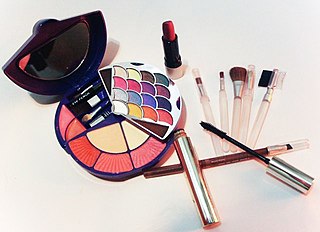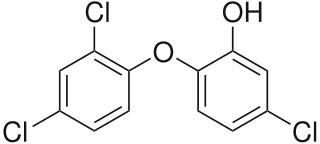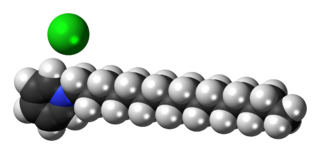Related Research Articles

A toxin is a naturally occurring organic poison produced by metabolic activities of living cells or organisms. They occur especially as proteins, often conjugated. The term was first used by organic chemist Ludwig Brieger (1849–1919) and is derived from the word "toxic".
A preservative is a substance or a chemical that is added to products such as food products, beverages, pharmaceutical drugs, paints, biological samples, cosmetics, wood, and many other products to prevent decomposition by microbial growth or by undesirable chemical changes. In general, preservation is implemented in two modes, chemical and physical. Chemical preservation entails adding chemical compounds to the product. Physical preservation entails processes such as refrigeration or drying. Preservative food additives reduce the risk of foodborne infections, decrease microbial spoilage, and preserve fresh attributes and nutritional quality. Some physical techniques for food preservation include dehydration, UV-C radiation, freeze-drying, and refrigeration. Chemical preservation and physical preservation techniques are sometimes combined.
Sodium laureth sulfate (SLES), an accepted contraction of sodium lauryl ether sulfate (SLES), also called sodium alkylethersulfate, is an anionic detergent and surfactant found in many personal care products and for industrial uses. SLES is an inexpensive and very effective foaming agent. SLES, sodium lauryl sulfate (SLS), ammonium lauryl sulfate (ALS), and sodium pareth sulfate are surfactants that are used in many cosmetic products for their cleaning and emulsifying properties. It is derived from palm kernel oil or coconut oil. In herbicides, it is used as a surfactant to improve absorption of the herbicidal chemicals and reduces time the product takes to be rainfast, when enough of the herbicidal agent will be absorbed.

Cosmetics are constituted mixtures of chemical compounds derived from either natural sources, or synthetically created ones. Cosmetics have various purposes. Those designed for personal care and skin care can be used to cleanse or protect the body or skin. Cosmetics designed to enhance or alter one's appearance (makeup) can be used to conceal blemishes, enhance one's natural features, add color to a person's face, or change the appearance of the face entirely to resemble a different person, creature or object. Due to the harsh ingredients in makeup products, individuals with acne-prone skin are more likely to suffer from breakouts. Cosmetics can also be designed to add fragrance to the body.

Toxic waste is any unwanted material in all forms that can cause harm. Mostly generated by industry, consumer products like televisions, computers, and phones contain toxic chemicals that can pollute the air and contaminate soil and water. Disposing of such waste is a major public health issue.

Environmental health is the branch of public health concerned with all aspects of the natural and built environment affecting human health. In order to effectively control factors that may affect health, the requirements that must be met in order to create a healthy environment must be determined. The major sub-disciplines of environmental health are environmental science, toxicology, environmental epidemiology, and environmental and occupational medicine.

Triclosan is an antibacterial and antifungal agent present in some consumer products, including toothpaste, soaps, detergents, toys, and surgical cleaning treatments. It is similar in its uses and mechanism of action to triclocarban. Its efficacy as an antimicrobial agent, the risk of antimicrobial resistance, and its possible role in disrupted hormonal development remains controversial. Additional research seeks to understand its potential effects on organisms and environmental health.

Methylisothiazolinone, MIT, or MI, is the organic compound with the formula S(CH)2C(O)NCH3. It is a white solid. Isothiazolinones, a class of heterocycles, are used as biocides in numerous personal care products and other industrial applications. MIT and related compounds have attracted much attention for their allergenic properties, e.g. contact dermatitis.
The International Nomenclature of Cosmetic Ingredients (INCI) are the unique identifiers for cosmetic ingredients such as waxes, oils, pigments, and other chemicals that are assigned in accordance with rules established by the Personal Care Products Council (PCPC), previously the Cosmetic, Toiletry, and Fragrance Association (CTFA). INCI names often differ greatly from systematic chemical nomenclature or from more common trivial names and is a mixture of conventional scientific names, Latin and English words. INCI nomenclature conventions "are continually reviewed and modified when necessary to reflect changes in the industry, technology, and new ingredient developments".

1,4-Dioxane is a heterocyclic organic compound, classified as an ether. It is a colorless liquid with a faint sweet odor similar to that of diethyl ether. The compound is often called simply dioxane because the other dioxane isomers are rarely encountered.

Household chemicals are non-food chemicals that are commonly found and used in and around the average household. They are a type of consumer goods, designed particularly to assist cleaning, house and yard maintenance, cooking, pest control and general hygiene purposes often stored in the kitchen or garage.

Cetylpyridinium chloride (CPC) is a cationic quaternary ammonium compound used in some types of mouthwashes, toothpastes, lozenges, throat sprays, breath sprays, and nasal sprays. It is an antiseptic that kills bacteria and other microorganisms. It has been shown to be effective in preventing dental plaque and reducing gingivitis. It has also been used as an ingredient in certain pesticides. Though one study seems to indicate cetylpyridinium chloride does not cause brown tooth stains, at least one mouthwash containing CPC as an active ingredient bears the warning label "In some cases, antimicrobial rinses may cause surface staining to teeth," following a failed class-action lawsuit brought by customers whose teeth were stained.

The European Directorate for the Quality of Medicines & HealthCare (EDQM) is a Directorate of the Council of Europe that traces its origins and statutes to the Convention on the Elaboration of a European Pharmacopoeia.
100,000,000 Guinea Pigs: Dangers in Everyday Foods, Drugs, and Cosmetics is a book written by Arthur Kallet and F. J. Schlink first released in 1933 by the Vanguard Press and manufactured in the United States of America. Its central argument propounds that the American population is being used as guinea pigs in a giant experiment undertaken by the American producers of food stuffs and patent medicines and the like. Kallet and Schlink premise the book as being "written in the interest of the consumer, who does not yet realize that he is being used as a guinea pig..."
DailyMed is a website operated by the U.S. National Library of Medicine (NLM) to publish up-to-date and accurate drug labels to health care providers and the general public. The contents of DailyMed is provided and updated daily by the U.S. Food and Drug Administration (FDA). The FDA in turn collects this information from the pharmaceutical industry.
TOXMAP was a geographic information system (GIS) from the United States National Library of Medicine (NLM) that was deprecated on December 16, 2019. The application used maps of the United States to help users explore data from the United States Environmental Protection Agency's (EPA) Toxics Release Inventory (TRI) and Superfund programs with visual projections and maps.
The Hazardous Substances Data Bank (HSDB) was a toxicology database on the U.S. National Library of Medicine's (NLM) Toxicology Data Network (TOXNET). It focused on the toxicology of potentially hazardous chemicals, and included information on human exposure, industrial hygiene, emergency handling procedures, environmental fate, regulatory requirements, and related areas. All data were referenced and derived from a core set of books, government documents, technical reports, and selected primary journal literature. Prior to 2020, all entries were peer-reviewed by a Scientific Review Panel (SRP), members of which represented a spectrum of professions and interests. Last Chairs of the SRP are Dr. Marcel J. Cassavant, MD, Toxicology Group, and Dr. Roland Everett Langford, PhD, Environmental Fate Group. The SRP was terminated due to budget cuts and realignment of the NLM.
Women's Voices for the Earth (WVE) is a feminist, women-led, North American environmental organization that specializes in research and advocacy regarding toxic chemicals used in products that disproportionately impact women's health, including cosmetics, menstrual care products, professional salon and cleaning products. WVE is a non-profit organization whose mission is to amplify women's voices to eliminate toxics that harm communities and health. With its inclusive vision of environmental work WVE has become a hub for visionary feminist environmentalism that recognizes the systemic connections between health, class, race, and the environment. Addressing the inter-connectivity of these various channels of exposure to toxic chemicals has been key to WVE's approach which is multi-scalar: targeting consumer behaviors, corporate practices, and government policies.

The term cosmetic packaging is used for cosmetic containers and secondary packaging of fragrances and cosmetic products. Cosmetic products are substances intended for human cleansing, beautifying and promoting an enhanced appearance without altering the body's structure or functions.
A Certified Organic Sunscreen, also known as Petrochemical-Free Sunscreen, is a third party certified sunscreen consisting of certified and approved organic ingredients, with typically zinc oxide acting as the photo-protector. An organic sunscreen is verified and approved by a certifier to an international organic standard, such as NSF/ANSI 305, which define production and labelling requirements for personal care products containing organic ingredients. Generally speaking, sunscreen has photo-protective properties that reduce the risk of skin cancer and ageing with relation to the SPF value and proper application.
References
- 1 2 3 Fung, Ernest; Drechsel, Derek; Towle, Kevin; Hoang, Melinda; Novick, Rachel; Poteete, Cayla; Paustenbach, Dennis; Monnot, Andrew (2018-06-16). "Screening-Level Safety Assessment of Personal Care Product Constituents Using Publicly Available Data". Cosmetics. 5 (2): 38. doi: 10.3390/cosmetics5020038 . ISSN 2079-9284.
- ↑ "About cpid-Why this database?". Consumer Product Information Database. Archived from the original on 31 March 2021. Retrieved 30 March 2020.
- 1 2 Slebodnik, Maribeth (2010). "Household Products Database". Reference Reviews. 24 (3): 36–37. doi:10.1108/09504121011030832.
- ↑ "New database reveals potential risks in household products". Journal & Courier. Lafayette, Indiana. 11 August 2003.
- ↑ "TOXNET Update: New Locations for TOXNET Content". National Library of Medicine. December 2019. Archived from the original on 18 March 2021. Retrieved 2021-03-31.